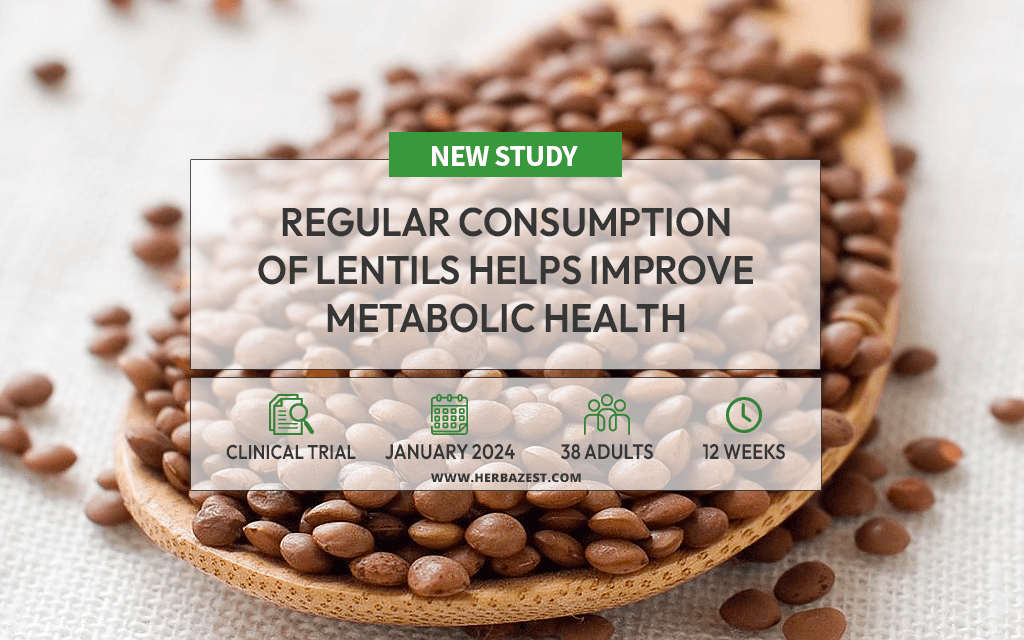Pulses, known for their rich nutritional profile, have garnered significant attention for their potential to enhance metabolic health.1 Among these, lentils stand out as a promising alternative to meat-based meals, especially for individuals at risk of metabolic diseases like type 2 diabetes, cardiovascular disease, and obesity. These conditions often require dietary interventions to halt their progression, and lentils, with their high fiber content, plant-based protein, and bioactive compounds, offer a compelling solution. A recent 2024 study conducted by American researchers explored the metabolic benefits of lentil consumption.
The Study
This 12-week clinical trial involved 38 adults with an increased waist circumference, a known risk factor for metabolic diseases. They were randomly assigned to one of two groups: a lentil-based meal group consuming 980 grams of cooked green lentils per week, or a control group consuming meat-based meals with no lentils.
The intervention meals were designed to be similar in protein and calorie content, but differed in their macronutrient composition, with the lentil meals being higher in fiber and carbohydrates and lower in fat compared to the meat-based meals.
Researchers' primary focus was on changes in glucose levels, cholesterol, and inflammation markers, with attention also given to any potential GI discomfort from increased pulse consumption.
The Results
The study found that regular lentil consumption significantly reduced fasting low-density lipoprotein (LDL) cholesterol and total cholesterol levels. In contrast, participants in the control group saw an increase in these cholesterol markers over the same period.
Moreover, lentil consumption was associated with a marked reduction in postprandial glucose levels and lower levels of key inflammation markers, such as interleukin-17 and interleukin-1 beta. These findings indicate that lentils can help mitigate the typical inflammatory response and glucose spikes that follow high-fat meals.
Importantly, participants reported mild or no GI discomfort, suggesting that regular lentil consumption is well-tolerated and does not exacerbate GI issues – a common concern that often deters people from increasing their pulse intake.
Additionally, there were no significant differences in waist circumference, body weight, or fat mass between the two groups, suggesting that the metabolic benefits of lentil consumption are independent of weight loss. This is particularly relevant for populations where weight loss is challenging, yet improvements in metabolic health are critically needed.
What Does this Mean?
The 2024 study provides compelling evidence that lentils can improve metabolic health, particularly for those at high risk of metabolic diseases. The reductions in cholesterol levels, glucose spikes, and inflammatory responses suggest that lentils may play a vital role in lowering the risk of cardiovascular disease and improving metabolic function.
The lack of significant GI discomfort also supports the regular inclusion of lentils in the diet, making them a practical option for long-term dietary strategies aimed at preventing and managing metabolic diseases.
In addition to lentils, other pulses like chickpeas, beans, and peas also offer numerous health benefits and could be valuable components of a health-promoting diet.
Sources
- Nutrients, Twelve Weeks of Daily Lentil Consumption Improves Fasting Cholesterol and Postprandial Glucose and Inflammatory Responses—A Randomized Clinical Trial, 2024
Footnotes:
- North Dakota State University. (2022). Pulses: The Perfect Food, Healthy to Eat, Healthy to Grow; Peas-Lentils-Chickpeas. Retrieved August 22, 2024, from https://www.ndsu.edu/agriculture/extension/publications/pulses-perfect-food-healthy-eat-healthy-grow-peas-lentils-chickpeas




